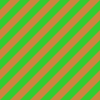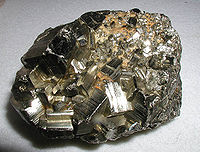- Chalcogen
-
Gruppe 16 Hauptgruppe 6 Periode 2 8
O3 16
S4 5 52
Te6 7 116
UuhDie Elemente der 6. Hauptgruppe des Periodensystems werden Chalkogene („Erzbildner“, v. griech.: „Χαλκός“ = Kupfer, Bronze + „γεννώ“ = erzeugen) genannt. Die Gruppe wird nach dem ersten Element auch als Sauerstoff-Gruppe bezeichnet. Nach der neueren Nummerierung der IUPAC der Gruppen handelt es sich um die Gruppe 16. Zu dieser Stoffgruppe gehören die Elemente Sauerstoff, Schwefel, Selen, Tellur, Polonium sowie das künstlich hergestellte Ununhexium.
Inhaltsverzeichnis
Vorkommen
Die Chalkogene kommen in der Natur in Form von Erzen und Mineralien vor (Metallchalkogenide, -oxide, -sulfate, -selenate wie z. B. Bleiglanz, Zinnober, Pyrit, Zinksulfid, Kupferkies, Silbertellurid), Sauerstoff und Schwefel auch elementar (Sauerstoff in Form von Luft, Schwefel oft im Zusammenhang mit vulkanischen Exhalationen, die Schwefelwasserstoff und Schwefeldioxid enthalten und zu Schwefel reagieren, ferner auch Schwefelsäure).
siehe auch: Oxide, Sulfide, Selenide, Telluride
Eigenschaften
Physikalische Eigenschaften
Die Chalkogene niedriger Ordnungszahl sind Nichtmetalle, wobei von Selen und Tellur auch metallische Modifikationen existieren: Selen und Tellur sind im Prinzip Halbmetalle, Polonium und Ununhexium Metalle.
Chemische Eigenschaften
Chalkogene reagieren mit Metallen zu erdigen und zum Teil auch basischen Metallchalkogenen (Oxide, Sulfide usw.). Mit Wasserstoff reagieren sie zu Chalkogenwasserstoffen (Wasser, Schwefelwasserstoff, Selenwasserstoff usw.).
Siehe auch:
Alkalimetalle | Erdalkalimetalle | Scandiumgruppe | Titangruppe | Vanadiumgruppe | Chromgruppe | Mangangruppe | Eisengruppe | Cobaltgruppe | Nickelgruppe | Kupfergruppe | Zinkgruppe | Borgruppe | Kohlenstoffgruppe | Stickstoffgruppe | Chalkogene | Halogene | Edelgase
Wikimedia Foundation.




